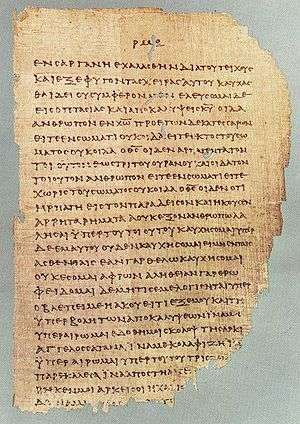Synod of Hippo
The Synod of Hippo refers to the synod of 393 which was hosted in Hippo Regius in northern Africa during the early Christian Church. Additional synods were held in 394, 397, 401 and 426. Some were attended by Augustine of Hippo.
The synod of 393 is best known for two distinct acts. First, for the first time a council of bishops listed and approved a Christian Biblical canon that corresponds to the modern Roman Catholic canon while falling short of the Orthodox canon (including the books classed by Roman Catholics as deuterocanonical books and by Protestants as Apocrypha). The canon was later approved at the Council of Carthage pending ratification by the "Church across the sea", that is, the See of Rome.[1] Previous councils had approved similar, but slightly different, canons. The council also reaffirmed the apostolic origin of the requirement of clerical continence and reasserted it as a requirement for all the ordained, in addition requiring that all members of a person's household must be Christian before that person can be ordained.[2][3]
Rules regarding clerical succession were also clarified at the Synod,[4] as well as certain liturgical considerations.[5]
Canonical scriptures
The canonical scriptures are listed in Canon xxxvi of Hippo as follows:[6]
- Genesis.
- Exodus.
- Leviticus.
- Numbers.
- Deuteronomy.
- Joshua the Son of Nun.
- The Judges.
- Ruth.
- The Kings, iv. books.
- The Chronicles, ii. books.
- Job.
- The Psalter.
- The Five books of Solomon.
- The Twelve Books of the Prophets.
- Isaiah.
- Jeremiah.
- Ezechiel.
- Daniel.
- Tobit.
- Judith.
- Esther.
- Ezra, ii. books.
- Macchabees, ii. books.
- The New Testament.
- The Gospels, iv. books.
- The Acts of the Apostles, i. book.
- The Epistles of Paul, xiv.
- The Epistles of Peter, the Apostle, ii.
- The Epistles of John the Apostle, iii.
- The Epistles of James the Apostle, i.
- The Epistle of Jude the Apostle, i.
- The Revelation of John, i. book.
In the De doctrina christiana, Augustine explains the relation between the two books of Ezra/Esdras and its separation with the Chronicles (partly included in the Septuagint's 1 Esdras): "...and the two of Ezra, which last look more like a sequel to the continuous regular history which terminates with the books of Kings and Chronicles."[7]
Notes
- ↑ Francis, Havey (1907), "African Synods", The Catholic Encyclopedia, New York: Robert Appleton Company, retrieved 2013-03-01
- ↑ Schaff, Philip; Wace, Henry, "Cannon XXXVI", The Seven Ecumenical Councils, Nicene and Post-Nicene Fathers: Second Series, XIV, Grand Rapids: William B Eerdmans Publishing Company, retrieved 2013-03-01
- ↑ Schrader, Charles (October 1936), "The Historical Development of the Papal Monarchy", The Catholic Historical Review, Catholic University of America Press, 22 (3): 259–282, ISSN 0008-8080, JSTOR 25013503
- ↑ Beaver, R Pierce (June 1936), "The Organization of the Church of Africa on the Eve of the Vandal Invasion", Church History, Cambridge University Press, 5 (2): 168–181, doi:10.2307/3160527, ISSN 0009-6407, JSTOR 3160527
- ↑ Shepherd, Massey Jr. (1961), "The Formation and Influence of Antiochene Liturgy", Dumbarton Oaks Papers, Dumbarton Oaks, 15: 23+25–44, doi:10.2307/1291174, ISSN 0070-7546, JSTOR 1291174
- ↑ "Canon XXIV. (Greek xxvii.)", The Canons of the 217 Blessed Fathers who assembled at Carthage, Christian Classics Ethereal Library
- ↑ Augustine of Hippo. On Christian Doctrine. Book II, Chapter 8.
